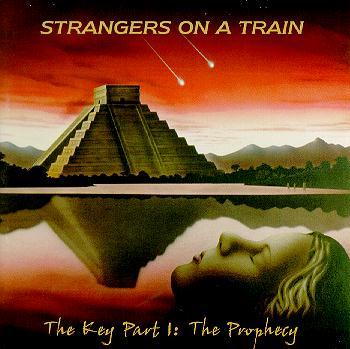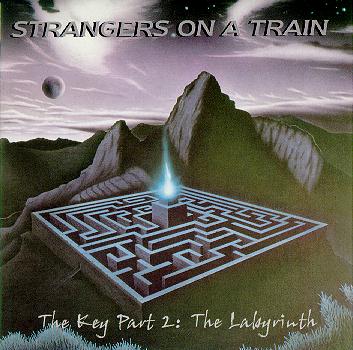© Russell W Elliot 1999
Last Updated 21 February 1999
 Image © 1997 Verglas Music |
 Image © 1998 Verglas Music |
|
Originally recorded between June and September 1990, this
masterwork by Clive Nolan,
Tracy Hitchings and Karl Groom
is one of the finest symphonic progressive rock
recordings available today. It must be listened to.
Strangers On A Train's The Key Part 1: The Prophecy (Verglas Music (UK) VGCD011, 1997) is the first of two completed albums in the planned three album series. With a total running time of over an hour, the album comprises fourteen moderate-length tracks that work together to deliver a majestic soundtrack-like epic. Clive Nolan's symphonic, classically-oriented writing and keyboards are perfectly complimented by Tracy Hitchings' stunning theatrically influence vocal work. Karl Groom's guitars and bass add the final dimension to the percussion-less instrumentals. It is clear from the introduction ("Arrival"), that the album is a masterpiece. The instrumentals set the stage for what is to follow and a short vocal passage illustrates the power, range and brilliance of Tracy Hitchings' vocals. The music features the three artists working together yet tracks and passages within others highlight and demonstrate the range and extent of their individual talents ("Losing A Hold On Life" [Nolan], "Lightshow" [Hitchings], "Duel" [Groom]). As expected from a symphonic work, the album has instrumental and vocal themes that bind it together into a cohesive whole. Almost train-like soundscapes can be heard within the music and perhaps are best illustrated at the begnning of the mini-epics "Sacrifice" and "Occam's Tears." These instrumentally strong tracks are interlaced with and complimented by Tracy's powerful emotionally-drenched vocals. The highly memorable vocal ballads ("New World," "Lightshow") fit perfectly within the overall album context but work equally by themselves (like singles). The tremendous Hitchings/Nolan duet "From The Outside In" while progressive in its own right, it has a light West End feel to it. The track is a perfect illustration of how Clive's soundtrack interest is complimented by Tracy's theatrical vocal style. The instrumental numbers are stunning in their own right but work well together to deliver a train-like theme between the more vocally rich tracks. "Silent Companion" builds from a low whistle melody before venturing into more typical synthesizer voices. A strong feeling of high speed mechanical movement comes from the bass guitar rich synthesizer track, "Crossing The Wasteland." A high speed piano - electric guitar duet in "Duel" further accentuates the transportation theme. Piano and light acoustic guitar provide a melodious introduction and then a foundation for Tracy's vocal scat which concludes the simply stunning [Renaissance-like] "Perchance To Dream." Tracy's vocal power perfectly complements the majesty of church organ-like keyboards and soaring electric guitar in "Healing The Rift." In the concluding track, "The Key," Tracy reiterates the theme introduced in the opening track to bring the album to a sensitive and dramatic close. The theme returns in The Key Part 2: The Labyrinth. Strangers On A Train's first album is a tremendous statement to the artists' talent and also their music's style. While comparisons may be difficult to make withouth the broadest appreciation of the progressive area they play in, clearly the band sound a lot like mainstream Renaissance (Dunford, Camp, Haslam, Sullivan, Tout) in many respects. Tracy Hitchings is a fantastic theatrical vocalist with tremendous range and power effectively illustrated by Clive Nolan's fantastic keyboard work and writing talent. The show-like, soundtrack quality of the music and total performance quality makes this album clearly one of the best we've ever heard. |
First released in 1993, Stranger On A Train's
second album The Key Part 2: The Labyrinth
(Verglas (UK) VGCD013, 1998) builds upon Part 1's
themes. This second of a planned three-album
series is truly a masterwork and one of the
finest symphonic progressive albums of all
time. It must be listened to.
Written by Clive Nolan (keyboards), the group also comprises Tracy Hitchings (vocals), Karl Groom (guitars, bass, drum programming [new in Part 2]) and Alan Reed (vocals). The album is more heavily orchestrated than the first with additional intrumental layers. The group's soundtrack-like style is taken to a higher level and complimenting male vocals further emphasise the show-like quality of the music. The five-part, 72-minute recording has three truly epic-length, multi-movement tracks ("Darkworld," "The Labyrinth," "Endzone") and two shorter tracks ("Hijrah," "The Vision Clears") with a balance of instrumental and vocal work. The opening instrumental movement of the epic "Darkworld" duet quickly reveals the depth of the orchestration within The Labyrinth album. Tracy Hitchings performs a stunning first vocal part in 'Edge Of Darkness.' 'Deliverance' follows with Alan Reed's vocals and develops into a lovely intertwined duet with Tracy. Her solo 'A Moment Of Sanity' follows with soaring electric guitar. The track then builds to a crescendo with the stunning and instrumentally rich Hitchings / Reed duet 'Beyond The Rubicon.' Tracy's scat carries a lovely melody in the instrumentally rich "Hurjah" with both backing and harp-like keyboards before a fast-paced, almost ragtime, piano part takes over. This leads to a heavily orchestrated, instrumentally rich, passage laced with extensive instrumentation and soaring (similar to Wakeman/Emerson-style) keyboard work. The feeling of mechanical transport clearly emerges before the track comes to a close. The orchestration further develops with a strong string theme in the introduction to the title track before the acoustic guitar takes over and Tracy's lead vocals begins. While other tracks illustrate her power and range, this track shows her incredible ability to sustain. The opening movement to "The Labyrinth", contains one of several highly memorable melodies found on this album. The title track concludes with a narrative second part and a heavy instrumental third part, both underscoring the mechanical motion, train-like, soundtrack theme. Certainly the most memorable 'single-like' track is the absolutely stunning "The Vision Clears." While progressively orchestrated, with it's almost hook-based chorus, this song has the feeling of what we'd imagine a Tracy Hitchings solo number to sound like -- almost like a torch ballad -- and it would be equally at home in several genres. The guitar-led instrumental bridge, however, plants the song clearly in its progressive home. A lovely keyboard-based introductory movement and second Alan Reed vocal part called 'Purification' open the final epic 'Endzone.' A third, spacy, choral-like keyboard movement called 'Recovery' follows before the fourth movement, 'The New Perspective,' begins. In a lighter style, this track is emotionally wrought and theatrically sung over light piano with lovely acoustic guitar parts between the sung portions. Powerful and sweet multi-tracked vocals join richly produced keyboards to conclude the movement. 'Denoument' begins with light instrumentation and Alan Reed's vocals. Themes developed earlier (Part I: "Arrival," "The Key," Part II: "Darkworld") are then drawn together as Tracy's vocals join in to form a fabulous complimentary duet prior to an explosive guitar-laced instrumental that concludes the album. |
| The two Strangers On A Train albums work
extremely well together with the second building
upon the strengths of the first and reaching
new heights orchestrally. The duets further
underscore the timeless show-like soundtrack
quality the band presents in their music.
The Verglas reissues are timely and well-produced
with attractive artwork. The booklets include
complete lyrics and other recording details
enthusiasts will appreciate. These are two
very fine CDs: "must-haves" for serious lovers
of symphonic progressive rock music featuring
female vocals. The third album in the trilogy
-- The Key Part III: The Legacy --
should be recorded in 1999 and emerge in 2000.
The latest release by Clive Nolan, Oliver Wakeman and Tracy Hitchings (amongst others) entitled Jabberwocky (Verglas (UK) VGCD014, 1999) is also highly recommended. Click here to check out our review. Return to website contents |